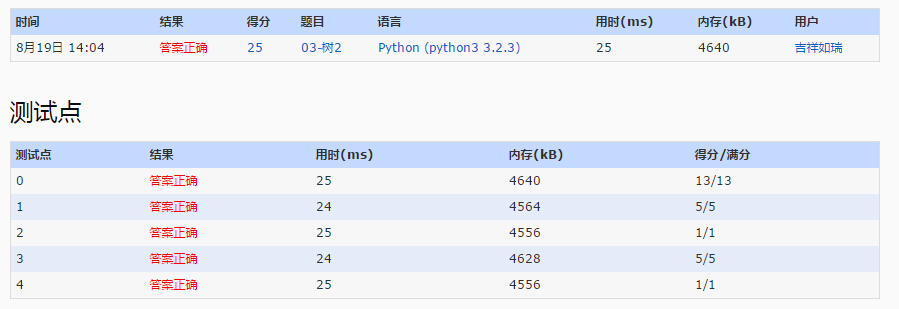03-树2. List Leaves (25)
题目要求
Given a tree, you are supposed to list all the leaves in the order of top down, and left to right.
Input Specification:
Each input file contains one test case. For each case, the first line gives a positive integer N (<=10) which is the total number of nodes in the tree – and hence the nodes are numbered from 0 to N-1. Then N lines follow, each corresponds to a node, and gives the indices of the left and right children of the node. If the child does not exist, a “-” will be put at the position. Any pair of children are separated by a space.
Output Specification:
For each test case, print in one line all the leaves’ indices in the order of top down, and left to right. There must be exactly one space between any adjacent numbers, and no extra space at the end of the line.
Sample Input:
8
1 -
- -
0 -
2 7
- -
- -
5 -
4 6
Sample Output:
4 1 5
题目分析
题目输入序列第一列给出树的节点个数N(N<=10);节点依次编号0~N-1;第一列之后个各个序列依次表示从0到N-1节点的左右子树,存在即为子孩子的序号,不存在就用’-‘表示。
首先,根据输入的信息建树,然后寻找根节点。寻找根节点的方法:用一个数组来标记每一个节点是否是其他节点的孩子节点,在输入中出现过得肯定不是根节点,因为输入的为节点左右孩子编号。
然后,从根开始层次遍历,将叶子节点保存,再按格式输出即可。
C语言实现
@C语言实现参考了ice_camel的博客,其C语言实现方式非常简洁便于理解;另外我Python代码也根据此思想编写的。
/*
BY:jixiangruuri
DATE:2015.08.18
C语言
Nothing Replace Hard Word
*/
#include <stdio.h>
#include <ctype.h>
struct Node
{
int root; //记录节点是否为根节点
int left; //左子树
int right; //右子树
};
int main(){
int n; //存储节点个数 N <= 10
struct Node nodes[10];
scanf("%d",&n);
//printf("%d",n);
for(int i = 0; i < n; i++){//初始化树节点
nodes[i].root = 1; //没有连接的节点都是根节点
nodes[i].left = -1; //没有左子树
nodes[i].right = -1; //没有右子树
}
for(int i = 0; i < n; i++){//构造树
char ch1,ch2;
scanf("\n%c %c",&ch1,&ch2);
if(isdigit(ch1)){ //左子树存在,将左子树连接至该点
nodes[i].left = ch1 - '0'; //指针指向左子树
nodes[ch1 - '0'].root = 0; //左子树取消根节点标记
}
if(isdigit(ch2)){
nodes[i].right = ch2 - '0';
nodes[ch2 - '0'].root = 0;
}
}
int root; //根节点序号
for(int i = 0; i < n; i++)
if(nodes[i].root == 1){
root = i;
break;
}
//构造完树后,层序遍历树,依次输出叶子节点;层序遍历:从根节点开始依次将左右儿子入队,直至队列为空
int leaves = 0; //记录输出叶节点的个数
int queue[10]; //节点队列,只保存节点下标
int head = 0, rear = 0;
queue[rear++] = root; //根节点入队
while(rear - head){
int node = queue[head++]; //队首节点出队
if(nodes[node].left == -1 && nodes[node].right == -1){
if(leaves) //输出第一个时,不输出空格
printf(" ");
printf("%d",node);
++leaves;
}
if(nodes[node].left != -1) //如果存在,左子树入队
queue[rear++] = nodes[node].left;
if(nodes[node].right != -1) //如果存在,右子树入队
queue[rear++] = nodes[node].right;
}
return 0;
}
Python实现
#! /usr/bin/env python
# -*- coding: utf-8 -*-
'''
BY:jixiangrurui
DATE:2015.08.19
Python:3.4.3
Nothing Replaces Hard Work
'''
def FindLeaves(seq,root):
'''(list of list of int, int) -> tuple of int
Return the tree's leaves node in a tuple
>>> seq = [[0, 1, -1], [0, -1, -1], [0, 0, -1], [1, 2, 7], [0, -1, -1], [0, -1, -1], [1, 5, -1], [1, 4, 6]] # [是否为根节点,左子树,右子树]
>>> root = 3
>>> FindLeaves(seq,root)
[4, 1, 5]
>>> seq = [[0, 4, -1], [0, 2, 7], [0, -1, -1], [0, -1, -1], [0, -1, -1], [1, 1, 6], [0, 0, 3], [0, -1, 8], [0, 9, -1], [0, -1, -1]]
>>> root = 5
>>> FindLeaves(seq,root)
[2,3,4,9]
'''
result = []
queue = []
queue.append(root)
while(len(queue) >0 ):
node = queue.pop(0)
if(seq[node][1] == -1 and seq[node][2] == -1):
result.append(node)
if(seq[node][1] != -1):
queue.append(seq[node][1])
if(seq[node][2] != -1):
queue.append(seq[node][2])
return result
if __name__ == '__main__':
# 输入数据
n = int(input()) # 节点长度
strs = [] # 接收树结构信息
for i in range(n):
strs.append(input().split(" "))
# 初始化树
seq = []
for i in range(n): # 初始化树[根节点,左子树,右子树]:是根节点为1,不是为0;左右子树,存在即为相应的序号,不存在为-1
seq.append([1,-1,-1])
for i in range(n):
if(strs[i][0] != '-'):
seq[i][1] = int(strs[i][0])
seq[int(strs[i][0])][0] = 0
if(strs[i][1] != '-'):
seq[i][2] = int(strs[i][1])
seq[int(strs[i][1])][0] = 0
# 寻找根节点
for i in range(n):
if(seq[i][0] == 1):
root = i
break
# 查找叶子节点
result = FindLeaves(seq,root)
for i in range(len(result)-1):
print(result[i],end=" ")
print(result[len(result)-1])

























 337
337











 被折叠的 条评论
为什么被折叠?
被折叠的 条评论
为什么被折叠?








